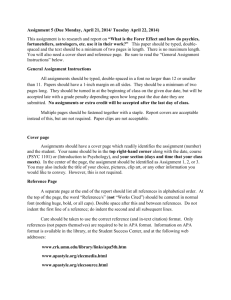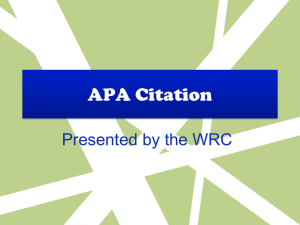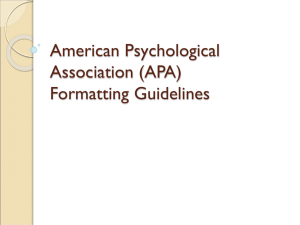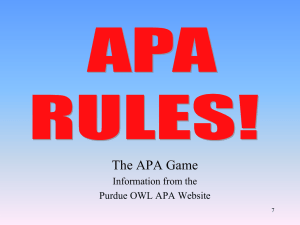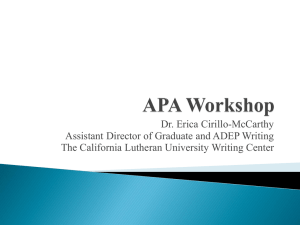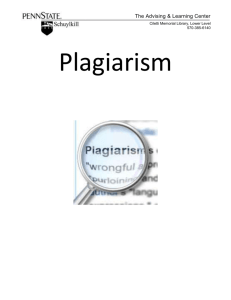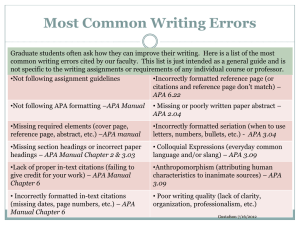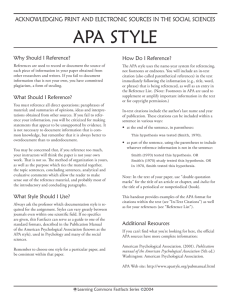APA - Florida Gulf Coast University
advertisement
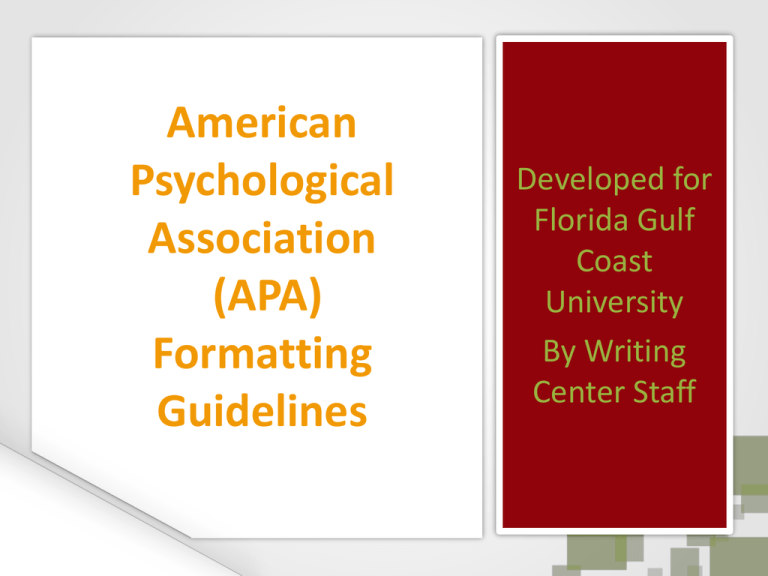
American Psychological Association (APA) Formatting Guidelines Developed for Florida Gulf Coast University By Writing Center Staff APA Style is used in research writing for several majors. Always check with your professor if you’re not sure which format to use. Business Education Criminology Economics Psychology Sociology Nursing Title page • Header should read “Running head:” followed by shortened title in capitals, followed by the page number: Running head: PRIMARY EDUCATION 1 • The running head should be no more than 50 characters (including spaces and punctuation) • Full title (12 or fewer words) should be centered in the upper half of the page • Title is followed by student’s name and university. Title page No more than 1 50 characters Running head: SHORT TITLE ALL CAPS IN HEADER 1 Full title is centered in upper half of the page Full Title of Paper: Sentence Case, Centered Left to Right Name of Student Author Name of University Abstracts When required, an abstract should be placed on the page immediately following the title page. • Indicate the thesis and main points of the paper. • Touch on the conclusions or implications of the research. • Do not indent on the first line. Abstract Brief summary describing purpose and findings of the paper Average length 150- 250 words RISK FACTORS 2 Abstract Community violence is recognized as a significant public health problem. However, only a paucity of research has examined risk factors for Written as a single paragraph with no indentations community violence exposure across Word “Abstract” centered at the top using longitudinal data. This study Includes a header (title and page number) in relation to community violence. domains relevant to adolescents or examined youth aggressive behavior Source: Lambert, S., et al. (2005). Risk factors for community violence exposure in adolescence. American Journal of Community Psychology. 36(1-2), pp. 29-49. Page Formatting Font Times New Roman 12-point Margins 1 inch Spacing double 5-space indent at the beginning of each paragraph Justification Left INTERACTIVE CONFLICT 5 Begun primarily with the focus on the study of peace and prevention of war (Harty & Modell, 1991), the field of conflict resolution has since expanded its influence to all spheres from family, to business and community, to international relations. The effort, in fact, has been to shift international conflict resolution from being primarily the domain of the government and the military to that of social scientists. The most difficult aspect of intergroup and international conflicts is their tendency to become protracted. Azar (1990) suggests that such conflicts occur “when communities are deprived of satisfaction of their basic needs on the basis of their communal identity” (p. 12). Paraphrase Writers cannot claim the words OR ideas of another as their own. Each time you paraphrase another author (put his or her ideas in your own words or summarize a passage), you must credit the source in the text. Paraphrase In your own words Cite with author and year of publication Critics of the workshops again called into question the applicability of a very intense method of human-relations training (the Tavistock model) to the situations of sensitive and volatile intergroup relations (Fisher, 1997). Short quotes fewer than 40 words Appears exactly the way it does in the original text Surrounded by quotation marks Cited with author, year of publication, and page number. If no page number, use paragraph number. Short quotes fewer than 40 words Azar (1990) suggests that such conflicts occur when “communities are deprived of satisfaction of their basic needs on the basis of their communal identity” (para. 12). Such conflicts occur when “communities are deprived of satisfaction of their basic needs on the basis of their communal identity” (Azar, 1990, p. 12). Block Quotes • Longer than 40 words • No quotation marks • Starts on a new line • Double-spaced • Whole quote indented ½” • Citation after the period Block Quote Contrary to conclusions reported by Dylan (1979) and Forbes (1980), new research demonstrated many things about placebo effects on behaviors. The placebo effect, which had been verified in previous studies, disappeared when behaviors were studied in this manner. Earlier studies were clearly premature in attributing the results to a placebo effect. (Smith, 1982, p. 234) Such future work must be both methodologically and scientifically sound. Citing multiple authors Use ‘&’ in parenthetical citations One author Smith (2002) or (Smith, 2002) Two authors Jones and Smith (2000) or (Jones & Smith, 2000) Three to five authors (first citation) (Williams, Jones, Smith, & Torrington, 2003) • Six and more authors (Williams et al., 2003) Citing an indirect source Name the original source in your signal phrase. List the secondary source in your reference list Include the secondary source in the parentheses. Levine (1998) (as cited in Barr, 2000) feels that students often fail to maximize their potential. Reference list: Use secondary source (Barr). Citing using titles when no author is listed Book title (Merriam-Webster’s Collegiate Dictionary, 2000) Article or chapter title (“Rats and Placebos,” 2003) Organization name (National Institute of Mental Health, 2001) Citation <---> Reference In-text citations must always match with the reference entries: In-text Citation “The club-and-bar scene is a new addition to the [student fun] list” (Levine & Cureton, 1998). Reference Entry Levine, A., & Cureton, J. (1998). When hope and fear collide: A portrait of today’s college student. San Francisco: Jossey-Bass Inc. References Alphabetize by author’s last name Double-space Hanging indent for each entry Article title - only capitalize first word Book title - italicize, only capitalize first word Journal title - italicize and capitalize all words References GUIDE TO WRITING 5 References Fine, M., & Kurdek, L. (1993). Reflections on determining authorship credit and authorship order on faculty-student collaborations. American Psychologist, 48, 1141-1147. GVU’s 8th WWW user survey. (n.d.). Retrieved from http://www.gatech.edu/gvu/ usersurveys/survey1 Nicol, A., & Pexman, P. (1999). Presenting your findings: A practical guide for creating tables. Washington, DC: American Psychological Association. Resources Tutorial about APA style • http://flash1r.apa.org/apastyle/basics/index.htm Sample APA paper • http://owl.english.purdue.edu/media/pdf/20090212013008_560.p df Robin Sontheimer University of Missouri-Kansas City Writing Center 2009 For more information please refer to the APA Manual or go to or go to www.apastyle.org
